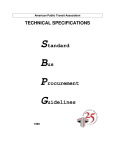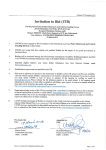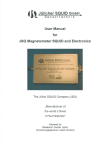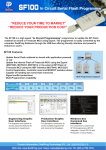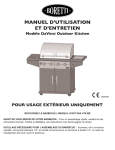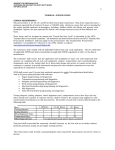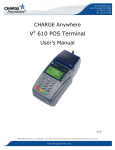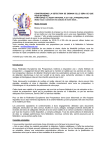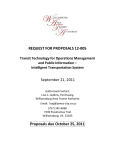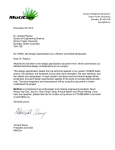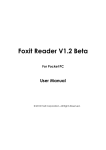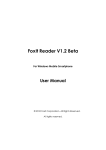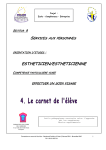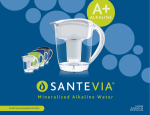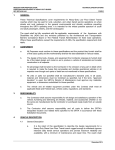Download URGEN NT 631-2014 4 ADDEN DUM 3
Transcript
Page 1 of 17 Co orporate Finance Department Materials M Managem ment Division 631-2014 4 ADDEN DUM 3 SUPPLY AN ND DELIVERY Y OF HEAVY Y-DUTY 40 FT T. LOW-FLOOR TRANSIT T BUSES ISSUED: Au ugust 13, 2014 BY: Glen Kuhl TELEPHONE NO. (204) 986--5801 URGEN NT PLEASE E FORWAR RD THIS DO OCUMENT T TO WHOEV VER IS IN POSSESSIO P ON OF THE E BID OPPORT TUNITY THIS ADDE ENDUM SHA ALL BE INCORPORATED INTO THE B BID OPPORT TUNITY AND D SHALL FORM A PA ART OF THE E CONTRACT T DOCUMEN NTS Template Version: A201311229 Pleas se note the fo ollowing and d attached ch hanges, corre ections, add itions, deletiions, informa ation and/or instructions s in con nnection with the Bid Op pportunity, an nd be govern ned accordin ngly. Failure e to acknowledge receiptt of this Addendum in Parragraph 9 of Form A: Bid may render your Bid no on-responsiv ve. PAR RT B – BIDDING PRO OCEDURES S Revisse: B2.1 to re ead: Add: The Subm mission Dea adline is 4:0 00 p.m. Winnipeg time,, August 20, 2014. B16 ELIGIBILITY E B16.1 Various V organ nizations provided investiga ative servicess with respectt to this Bid Opportunity y. In the City’’s opinion, thi s relationship p or associatio on does not ccreate a conflict of in nterest or will not likely cre eate a perception of conflicct of interest b because of this disclosure. The organizations are re: (i) ( New Flyer F Industrie es Ltd. (ii) ( Nova Bus PAR RT D – SUP PPLEMENT TAL COND DITIONS Revisse: D2.1 to re ead: The Work to be done un nder the Contrract shall con nsist of the supply and delivvery of low floor transitt diesel buses s from the datte of award to o October 30thh, 2015, with the option of four (4) mutually agrreed upon on ne (1) year e extensions. Revisse: D2.1 (a) to o read: Each (4) fo our year extension will be e for approxim mately thirty-th hree (33) low floor transit diesel buse es. Remove: From D2 2.5: In-process s drawings Revisse: D2.5 to re ead: 30 days s prior to pilo ot bus Scale e drawings 1 Refere encing APTA Guideline SP P 2.3 Contractt Deliverabless: Contract delive erables assoc ciated with this Contractt are set forth h in the table e below, alon ng with otherr perrtinent inform mation. Conttract delivera ables shall b e submitted in accordan nce with E1. D Due dates sho own note the e last acceptable date forr receipt of C Contract deliv verables. Alll documents s must be acc ceptable to th he City. All parts p and serrvice correcttions must b be made, on tthe master electronic cop py, within 30 0 days of notice. The elec ctronic corre ections must be followed by all hardc copy updates s witthin 90 days of notice. Th he City will consider early y receipt of C Contract deliverables on n a case-by- Bid Opportunity No. 631-2014 ADDENDUM 3 Page 2 of 17 case basis. The reference section designates the appropriate specification section(s) where the requirement is referenced. Contract Deliverables Deliverable Due Date Quantity Due Format Material samples Pre-production meeting Undercoating system program Pre-production meeting Electronic 1 Technical review of electronic functionality Pre-production meeting Hardcopy Electronic 1 1 Interior security camera layout Pre-production meeting Electronic 1 Technical review of powerplant Pre-production meeting Electronic 1 Engineering support Pre-production meeting Contracts 1 List of OEM component repair manuals Pre-production Meeting Hardcopy 1 Training – 100 instructor hours per contract year Accumulated hours to be used by the end of the contract 100 hours Pre-production meeting minutes 15 days after each meeting Electronic 2 originals Recommended spare parts list Provided 10 business after Electronic the Pilot Bus delivery 1 Part number index Provided 10 business after Electronic the Pilot Bus delivery 1 Current price list 30 days prior to pilot bus Electronic 1 Striping layout 30 days prior to pilot bus Hardcopy 1 Resolution of issues “subject 30 days prior to pilot bus to City approval” Hardcopy 1 Preliminary Parts & Service Manual Electronic 1 All available OEM manuals With pilot bus (including but not limited to engine, transmission, passenger seating, HVAC, etc.) Hardcopy Electronic 3 1 Complete Engineering Bill of With pilot bus Material. Electronic 1 Electrical and air schematics With pilot bus Hardcopy Electronic 3 1 Glazing drawings/spec for all With pilot bus window glass on the bus Electronic 1 Current index file displaying With pilot bus all Part Numbers, description, manual location, Build #. Electronic 1 With pilot bus 1 Bid Opportunity No. 631-2014 ADDENDUM 3 Page 3 of 17 Contract Deliverables Deliverable Due Date Quantity Due Format Engine Emissions Certificate With pilot bus — NOx levels Hardcopy 1 List of serialized units installed on each bus With each bus Electronic 1 per bus QA manufacturing certificate With each bus Hardcopy 1 per bus Pre-Delivery Bus Documentation Package With each bus Hardcopy 1 per bus Motor Vehicle Pollution Requirements Certificate With each bus Hardcopy 1 Operator’s log and incident report With each bus Hardcopy 1 per bus Title documentation With each bus Hardcopy 1 per bus As-built drawings Within 60 days after final Electronic bus delivery Media Final Manuals - current 90 days after pilot bus service manual(s) and OEM manuals to include preventative maintenance procedures, diagnostic procedures or troubleshooting guides and major component service manuals, current parts manual(s), and standard operator’s manual(s) 1 Electronic 7 per build (total) 1 Hardcopy All electronic software To be held in escrow Electronic 1 Each Bus Supplier / OEM Part Number Cross-reference, including OEM identification and contact information 90 days after pilot bus Electronic 1 Each All full versions of diagnostic 90 days after pilot bus and programming software, licenses and necessary patch cables and associated hardware for all vehicle subsystems Revise: D17.1 to read: Hardcopy 1 Electronic 10 per build Patch cable 10 Referencing APTA Guideline SP 7.2 Documentation: The Contractor shall exert its best efforts to keep maintenance manuals, operator manuals and parts books up to date for a period of twelve (12) years. The supplied manuals shall incorporate all equipment ordered on the buses covered by this procurement. In instances where copyright restrictions or other considerations prevent the Contractor from incorporating major components information into the bus parts and service manuals, separate manual sets as published by the subcomponent supplier will be provided. Bid Opportunity No. 631-2014 ADDENDUM 3 Page 4 of 17 Revise: D19.1 (a) to read: Referencing APTA Guideline WR 1.1.2 Complete Bus: The complete bus (excluding City of Winnipeg installed items), propulsion system, components, all subsystems and body and chassis structure are warranted to be free from defects and related defects for one year or 80,000 kilometres, whichever comes first, beginning on the date of revenue service but not longer than 15 days after acceptance under “Inspection, Testing and Acceptance.” The warranty is based on regular operation of the bus under the operating conditions prevailing in the City’s locale. In the event of “coach down” for repairs, in excess of 14 days, the warranty date shall be adjusted to compensate for the days the coach was not in revenue service. In the event of Coach Down for warranty repairs, in excess of 30 days, Liquidated Damages as referenced in D12 shall be incurred. Revise: D19.1 (d) to read: Referencing APTA Guideline WR1.1.5 Emission Control System (ECS): The Contractor warrants the emission control system for five years or 160,000 kilometres, whichever comes first. The ECS shall include, but is not limited to, the following components: Revise: • complete exhaust system, including catalytic converter (if required) • after-treatment device • components identified as emission control devices D19.1 (f) to read: Referencing APTA Guideline WR 1.1.7 Extended Warranty: The City requires the following additional subsystems to be warranted to be free from Defects and Related Defects for three years or 300,000 miles whichever comes first. • Revise: Shock absorbers D19.1 (i) to read: Referencing APTA Guideline WR 1.3.1 Pass-Through Warranty The Contractor shall not transfer warranty responsibility to any sub-Supplier, or to others. The Contractor shall be solely responsible for the administration of the warranty as specified with exception of the following; engine, transmission, HVAC, destination signs and batteries. Clarification of D19.1 (n): The intention is that Winnipeg Transit will handle normal warranty defects with complete reimbursement per warranty specifications. Revise: D19.2 to read: Further to C11, the City and the Contractor may negotiate an agreement for the City’s own forces to perform warranty repair work under the following conditions: (a) monthly warranty repairs beyond 100 hours shall be charged at overtime rates; (b) the Contractor will either supply all materials necessary to perform the warranty repair or reimburse to the City, the full costs of parts and materials supplied by the City within 60 Calendar Days of use; (c) labour rates for warranty repair work performed by City forces during normal working hours will be $ 95.00 per person hour, the overtime labour rate will be $ 120.00 per person hour. Bid Opportunity No. 631-2014 ADDENDUM 3 Page 5 of 17 PART E – SPECIFICATIONS Revise: E2.17 to read: Referencing APTA Guideline TS 5.8 Noise: Interior Noise The combination of inner and outer panels and any material used between them shall provide sufficient sound insulation so that a sound source with a level of 80 dBA measured at the outside skin of the bus shall have a sound level of 65 dBA or less at any point inside the bus. These conditions shall prevail with all openings, including doors and windows, closed and with the engine and accessories switched off. The bus-generated noise level experienced by a passenger at any seat location in the bus shall not exceed 80 dBA. The operator area shall not experience a noise level of more than 75 dBA. Exterior Noise Airborne noise generated by the bus and measured from either side shall not exceed 80 dBA under full power acceleration when operated 0 to 55 km/h at curb weight. The maximum noise level generated by the bus pulling away from a stop at full power shall not exceed 83 dBA. The bus-generated noise at curb idle shall not exceed 65 dBA. If the noise contains an audible discrete frequency, a penalty of 5 dBA shall be added to the sound level measured. The Contractor shall comply with the exterior noise requirements defined in local laws and ordinances identified by the City and SAE J366. Revise: E2.24 to read: Referencing APTA Guideline TS 6.4 Step Height The step height shall not exceed 14.6 inches at either doorway without kneeling. A maximum of two steps is allowed to accommodate a raised aisle floor in the rear of the bus. Revise: E2.29 to read: Referencing APTA Guideline TS 6.8 Floor Height: Height of the step above the street shall be no more than 14.6 in. measured at the centerline of the front and rear doorway. The floor may be inclined along the longitudinal axis of the bus, and the incline shall not exceed 3.5 degrees off the horizontal except locally at the doors where 2 degree slope toward the door is allowed. All floor measurements shall be with the bus at the design running height and on a level surface and with the standard installed tires. A maximum of two steps is allowed to accommodate a raised aisle floor in the rear of the bus. Revise: E2.31 to read: Referencing APTA Guideline TS 6.10 Aisle Width: The minimum clear aisle width between pairs of transverse seats with all attached hardware shall be at least 22 inches. The aisle width between the front wheelhouses shall be at least 35 inches, and the entire area between the front wheelhouses shall be available for passengers and mobility aid devices. Revise: E2.43 to read: Referencing APTA Guideline TS 10.1 Engine Cooling: A means of determining satisfactory engine coolant level shall be provided. A spring-loaded, push-button type valve or lever shall be provided to safely release pressure or vacuum in the cooling system with both it and the water filler no more than 60 inches above the ground. Both shall be accessible through the same access door. The radiator shall be of durable, corrosion-resistant construction with removable tanks. The radiator or coolant system drain shall be easily accessible from the engine compartment and equipped with a flat Bid Opportunity No. 631-2014 ADDENDUM 3 Page 6 of 17 faced coupler manufactured by “Stucchi”. Stucchi coupler #800901001 and protective boot #815100001. Radiators with a fin density greater than 12 fins per inch or a louvered slit design shall not be used. No heatproducing components or climate control system components shall be mounted between the engine cooling air intake aperture and the radiator. The radiator and charge air cooler shall be designed to withstand thermal fatigue and vibration associated with the installed configuration. The radiator and charge air cooler cores shall be easily cleaned (to include engine side core surface) with standard pressure-washing equipment or using high volume, low pressure if water is used to clean the system. Screen in Front of Radiator and Charge Air Cooler For radiators with lower edge less than 36 inches to the ground The radiator and air cooler shall be protected by an aluminum perforated screen with staggered ¼” holes. The screen shall be capable of maintaining sufficient air flow for the cooling requirements. Standard Requirement for Coolant Filtration The engine cooling system shall be equipped with a properly sized water filter with a spin-on element and an automatic system for releasing supplemental coolant additives as needed to replenish and maintain protection properties. When replacing the water filter, only the water in the filter will be lost. Cooling Fan Control and Drive Design Control and drive of the radiator and charge air cooler fan(s) shall be an electric EMP or Modine system. The cooler fans shall have integrated controllers. Cooler fans shall be capable of automated reverse operations for periodic self-cleaning of the radiator and charge air cooler. Radiator cooling and Charge Air cooling must operate independently. Clarification of E2.49 to: Oil Pressure and Coolant gauges can be mechanical gauges, electrical gauges or digital display. Revise: E2.54 to read: Referencing APTA Guideline TS 15. Radiator: Radiator piping, within 36 inches of the ground, shall be stainless steel or brass tubing, and if practicable, hoses shall be eliminated. Necessary hoses shall be impervious to all bus fluids. All hoses shall be secured with stainless steel clamps that provide a complete 360-degree seal. The clamps shall maintain a constant tension at all times, expanding and contracting with the hose in response to temperature changes and aging of the hose material. Revise: E2.59 to read: Referencing APTA Guideline TS 17.2.1 Design and Construction, Diesel: Fuel Tank(s) The fuel tank(s) shall be made of high-density cross-linked polyethylene plastic material. Installation The fuel tank(s) shall be securely mounted to the bus to prevent movement during bus maneuvers. The fuel tank(s) shall be equipped with an external, hex head, drain plug. It shall be at least a ⅜-inch size and shall be located at the lowest point of the tank(s). The fuel tank(s) shall have an inspection plate or easily removable filler neck to permit cleaning and inspection of the tank(s) without removal from the bus. The tank(s) shall be baffled internally to prevent fuel-sloshing noise regardless of fill level. The baffles or fuel pickup location shall assure continuous full power operation on a 6 percent upgrade for 15 minutes starting with no more than Bid Opportunity No. 631-2014 ADDENDUM 3 Page 7 of 17 95 litres of fuel over the unusable amount in the tank(s). The bus shall operate at idle on a 6 percent downgrade for 30 minutes starting with no more than 38 litres of fuel over the unusable amount in the tank(s). The materials used in mounting shall withstand the adverse effects of road salts, fuel oils, and accumulation of ice and snow for the life of the bus. Labeling The capacity, date of manufacture, manufacturer name, location of manufacture, and certification of compliance to Federal Motor Carrier Safety Regulation shall be permanently marked on the fuel tank(s). The markings shall be readily visible and shall not be covered with an undercoating material. Fuel Filler The fuel filler shall be located 7 to 33 feet behind the centerline of the front door on the curb side of the bus. The filler cap shall be retained to prevent loss and shall be recessed into the body so that spilled fuel will not run onto the outside surface of the bus. The fuel lines forward of the engine bulkhead shall be in conformance to SAE Standards. Dry-break fuel filler The fuel filler shall accommodate a nozzle that forms a locked and sealed connection during the refueling process to eliminate spills. Fuel shall not be allowed to flow into the tank unless the nozzle has been properly coupled, locked and sealed to the filler. With the nozzle open, fuel shall enter the tank at a fill rate of not less than 150 litres per minute of foam-free fuel without causing the nozzle to shut off before the tank is full. The nozzle shall automatically shut off when the tank is essentially full. Once disconnected, fuel shall not be allowed to flow through the nozzle at any time. Any pressure over 3 psi shall be relieved from the fuel tank automatically. An audible signal shall indicate when the tank is essentially full. The dry break system shall be compatible with the City’s system. The fuel filler cap shall be hinged. Revise: E2.69 to read: Referencing APTA Guideline TS 22.2 Crashworthiness: The bus body and roof structure shall withstand a static load equal to 150 percent of the curb weight evenly distributed on the roof with no more than a 6 in. reduction in any interior dimension. Windows shall remain in place and shall not open under such a load. These requirements must be met without the roof-mounted equipment installed. The bus shall withstand a 40 km/h impact by a 1800 kg automobile at any side, excluding doorways, along either side of the bus with no more than 3 in. of permanent structural deformation at seated passenger hip height. This impact shall not result in sharp edges or protrusions in the bus interior. Exterior panels below 35 inches from ground level shall withstand a static load of 907 kg applied perpendicular to the bus by a pad no larger than 5 square inches. This load shall not result in deformation that prevents installation of new exterior panels to restore the original appearance of the bus. Revise: E2.70 to read: Referencing APTA Guideline TS 23. Corrosion: The bus flooring, sides, roof, under-structure and axle suspension components shall be designed to resist corrosion or deterioration from atmospheric conditions and all de-icing materials for a period of 18 years or 1.2 million kilometres, whichever comes first. It shall maintain structural integrity and nearly maintain original appearance throughout its service life. All materials that are not inherently corrosion resistant shall be protected with corrosion-resistant coatings. All joints and connections of dissimilar metals shall be corrosion resistant and shall be protected from galvanic corrosion. Representative samples of all materials and connections shall withstand a two-week (336-hour) salt Bid Opportunity No. 631-2014 ADDENDUM 3 Page 8 of 17 spray test in accordance with ASTM Procedure B-117 with no structural detrimental effects to normally visible surfaces and no weight loss of over 1 percent. Corrosion Resistance Requirements for Exposed and Interior Surfaces of Tubing Throughout Entire Vehicle All exposed surfaces of tubing and other enclosed members shall be corrosion resistant through application of a corrosion protection system. All interior surfaces, excluding corrosion resistant stainless, shall be corrosion resistant through application of a corrosion protection system. Revise: E2.116 to read: Referencing APTA Guideline TS 37.3 Air Lines and Fittings: Air lines, except necessary flexible lines, shall conform to the installation and material requirements of SAE Standard J1149 for copper tubing with standard, brass, flared or ball sleeve fittings, or SAE Standard J844 for nylon tubing if not subject to temperatures over 200 oF. The air on the delivery side of the compressor where it enters nylon housing shall not be above the maximum limits as stated in SAE J844. Nylon tubing shall be installed in accordance with the following color-coding standards: • Green: Indicates primary brakes and supply. • Red: Indicates secondary brakes. • Brown: Indicates parking brake • Yellow: Indicates compressor governor signal. • Black: Indicates accessories. Line supports shall prevent movement, flexing, tension, strain, chafing and vibration. Copper lines shall be supported to prevent the lines from touching one another or any component of the bus. To the extent practicable and before installation, the lines shall be pre-bent on a fixture that prevents tube flattening or excessive local strain. Copper lines shall be bent only once at any point, including pre-bending and installation. Rigid lines shall be supported at no more than 5-ft intervals. Nylon lines may be grouped and shall be supported at 30 in. intervals or less or as approved by property inspector (agency). The compressor discharge line between powerplant and body-mounted equipment shall be flexible Teflon hose with a braided stainless steel jacket. All lines necessary to maintain system reliability shall be flexible Teflon hose with a braided stainless steel jacket. End fittings shall be standard SAE or JIC brass or steel, flanged, swivel-type fittings. Flexible hoses shall be as short as practicable and individually supported. They shall not touch one another or any part of the bus except for the supporting grommets. Flexible lines shall be supported at 2-ft intervals or less or as approved by property inspector (agency). Air lines shall be clean before installation and shall be installed to minimize air leaks. All air lines shall be routed to prevent water traps to the extent possible. Grommets or insulated clamps shall protect the air lines at all points where they pass through understructure components. Revise: E2.136 to read: Referencing APTA Guideline TS 40.5 Electrical Compartments: All relays, controllers, flashers, circuit breakers and other electrical components shall be mounted in easily accessible electrical compartments. All compartments exposed to the outside environment shall be corrosionresistant and sealed. The components and their functions in each electrical compartment shall be identified and their location permanently recorded on a drawing attached to the inside of the access panel or door when possible. The drawing shall be protected from oil, grease, fuel and abrasion. The front compartment shall be completely serviceable from the operator’s seat, vestibule or from the outside. “Rear start and run” controls shall be mounted in an accessible location in the engine compartment and shall be protected from the environment. The PLC shall be initialized from the rear engine compartment when the following conditions are met; Bid Opportunity No. 631-2014 ADDENDUM 3 Page 9 of 17 • • • Revise: rear run switch is in the rear run position start push button held for 5 seconds audio/visual warning activated; (i.e. back-up lights/amber light flashing) E2.145 to read: Referencing APTA Guideline TS 42.1 General: The primary purpose of the multiplexing system is control of components necessary to operate the vehicle. This is accomplished by processing information from input devices and controlling output devices through the use of an internal logic program. Versatility and future expansion shall be provided for by expandable system architecture. The multiplex system shall be capable of accepting new inputs and outputs through the addition of new modules and/or the utilization of existing spare inputs and outputs. All like components in the multiplex system shall be modular and interchangeable with self-diagnostic capabilities. The modules shall be easily accessible for troubleshooting electrical failures and performing system maintenance. Multiplex input/output modules shall use solid-state devices to provide extended service life and individual circuit protection. All modules shall be repairable at the component level. Ten percent of the total number of inputs and outputs, or at least one each for each voltage type utilized (0V, 12V, 24V), at each module location shall be designated as spares. The Contractor must supply 4 - notebook computers per bus build to be used for diagnostic and programming functions. The computers must be equipped with the latest version of the Windows operating system, colour screens, integral pointing devices, CD Rom Drives, floppy drive, the largest capacity hard drive available for the computer and twice the minimum RAM memory required to run all applicable software. The computers shall be equipped with the latest versions of all software required for diagnostics and programming of the Engine, Transmission, PLC, ABS, Electronic Signs, and all other Electronic equipment included in the vehicle. All software must be installed and functional. The computers shall include all peripheral communication hardware, such as PIC’s, links and adapters used in downloading and programming of the equipment. Data Link connectors shall be provided 10 connectors per bus build to function with computer equipment and all applicable software provided. Cigarette type plug-in to be provided at Lap Top diagnostic plug locations for Lap Top operation. The City of Winnipeg shall have final approval of the hardware and software to be supplied. Computers supplied under contract must be available for testing of all functions and data link connections during pre-delivery inspections. Revise: E2.163 to read: Referencing APTA Guideline TS 44.5 Normal Bus Operation Instrumentation and Controls: The following list identifies bus controls used to operate the bus. These controls are either frequently used or critical to the operation of the bus. They shall be located within easy reach of the operator. The operator shall not be required to stand or turn to view or actuate these controls unless specified otherwise. Systems or components monitored by onboard diagnostics system shall be displayed in clear view of the operator and provide visual and/or audible indicators. The intensity of indicators shall permit easy determination of on/off status in bright sunlight but shall not cause a distraction or visibility problem at night. All indicators shall be illuminated using backlighting. The indicator panel shall be located in Area 1 or Area 5, within easy view of the operator instrument panel. All indicators shall have a method of momentarily testing their operation. The audible alarm shall be tamperresistant and shall have an outlet level between 80 and 83 dBA when measured at the location of the operator’s ear. Bid Opportunity No. 631-2014 ADDENDUM 3 Page 10 of 17 On-board displays visible to the operator shall be limited to indicating the status of those functions described herein that are necessary for the operation of the bus. All other indicators needed for diagnostics and their related interface hardware shall be concealed and protected from unauthorized access. Table 6 represents instruments and alarms. The intent of the overall physical layout of the indicators shall be in a logical grouping of systems and severity nature of the fault. Consideration shall be provided for future additions of spare indicators as the capability of onboard diagnostic systems improves. Blank spaces shall contain LEDs. Transit Bus Instruments and Alarms Device Description Location Function Visual/ Audible Master run switch Rotary, fourposition detent Master control for bus, off, Side console day run, night run and clearance ID lights Engine start, front Approved momentary switch Side console Engine start, rear Approved momentary switch Engine Activates engine starter compartment motor Engine run, rear Three-position toggle switch Permits running engine Engine from rear start, normal front Amber light compartment run position and off Drive selector Touch panel switch Dash right wing HVAC Switch or switches to control HVAC Permits selection of passenger ventilation: off, Side console cool, heat, low fan, high fan or full auto with on/off only Operator’s ventilation Rotary, threeposition detent Above Side console or Dash left wing Permits supplemental ventilation: fan off, low or high Defroster fan Rotary, fourposition detent Dash left wing Permits defroster: fan off, low, medium and high Variable position Dash left wing Adjusts defroster water flow and temperature Windshield wiper Variable rotary position operating each wiper separately Dash left wing Variable speed control of left and right windshield wipers Windshield washer Push button Dash left wing Activates windshield washers Defroster temperature Activates engine starter motor Provides selection of propulsion: forward, reverse and neutral Gear selection Bid Opportunity No. 631-2014 ADDENDUM 3 Page 11 of 17 Transit Bus Instruments and Alarms Device Description Location Function Visual/ Audible Provides adjustment for light intensity in night run position Dash panel lights Rotary rheostat or stepping switch Dash left wing Interior lights Two-position switch Selects mode of passenger Side console compartment lighting: off, on Fast idle Two-position switch Side console Selects high idle speed of engine Side console – within hand Permits deploy and stow of Red light, reach of door front ramp warning alarm control handle Front door ramp Three-position momentary switch Front kneel Side console Three-position – within hand Permits kneeling activation momentary switch reach of door and raise and normal at with protective control front door remote location guard handle Right remote mirror Permits two-axis Four-position toggle Side console adjustment of right exterior type mirror Mirror heater Temperature activated Amber indicator. Ext alarm and Amber light Permits heating of outside mirrors when required Permits open/close control Passenger door Five-position handle Side console, of front and rear passenger Red light control type detent forward doors Rear door override Side console, within hand Allows operator to override Two-position reach of door activation of rear door switch in passenger tape switches approved location control handle Engine shutdown override Momentary switch with protective cover Permits operator to Side console override auto engine shutdown Two-position switch Activates emergency Hazard flashers with 50mm actuator Side console flashers lever Mobile data terminal Mobile data terminal coach operator interface panel Above right dash wing Facilitates operator interaction with communication system and master log-on Two green lights LCD display with visual status and text messages Bid Opportunity No. 631-2014 ADDENDUM 3 Page 12 of 17 Transit Bus Instruments and Alarms Device Farebox interface Description Farebox coach operator interface panel Location Function Facilitates operator Near farebox interaction with farebox system Visual/ Audible LCD display in approved location Facilitates operator interaction with destination sign system, manual entry LCD display Turn signals Momentary push button (two required) raised from other switches Left foot panel Activates left and right turn signals Two green lights and audible indicator PA manual Momentary push button Left foot panel Permits operator to manually activate public address microphone Microphone Atlas Sound gooseneck assembly or GFI (Genfare) gooseneck assembly Left front corner of the operator’s compartment. Permits operator to make announcements with both hands on the wheel and focusing on road conditions High beam Detent push button Permits operator to toggle Left foot floor between low and high beam Blue light Parking brake Pneumatic PPV Below or on Permits operator to apply Side console and release parking brake Red light Park brake release Pneumatic PPV Below or on Permits operator to push Side console and hold to release brakes Park brake alarm Alarm Under Dash Remote engine speed Rotary rheostat Permits technician to raise Engine and lower engine RPM compartment from engine compartment Master brake interlock Toggle, with protective guard Overhead left Permits operator override Out of to disable brake/throttle operator’s interlock reach Toggle switch Overhead left Out of Permits operator override operator’s to disable door reach Destination sign Destination sign interface interface panel Master door Warns operator park brake disabled when master switch off Buzzer Bid Opportunity No. 631-2014 ADDENDUM 3 Page 13 of 17 Transit Bus Instruments and Alarms Device Description Location Function Visual/ Audible Warning interlocks deactivated Red light and Alarm Dash panel center Illuminates to warn operator Red light and that interlocks have been Alarm deactivated. Retarder disable Toggle switch Within reach of Operator Permits operator override to disable brake retardation/regeneration Auxiliary power 12 volt power receptacle Approved locations Diagnostic Connector Speedometer Speedometer, odometer, and diagnostic capability, 10 kilometres increments, no trip meter Dash center panel Visual indication of speed and distance traveled, accumulated vehicle kilometres, fault condition display Visual Air pressure gauge Primary and secondary, 5 psi increments Dash center panel Visual indication of primary and secondary air systems Red light and buzzer Fire detection Coach operator display Property specific or dash center Indication of fire detection activation by zone/location Buzzer and red light Door obstruction Sensing of door obstruction Dash center Indication of rear door sensitive edge activation Red light and Buzzer Door ajar Door not properly closed Property specific or dash center Indication of rear door not properly closed Alarm and red light Low system air pressure Sensing low primary and secondary air tank pressure Dash center Indication of low air system Buzzer and red pressure light Engine coolant indicator Low coolant indicator may be Within supplied as audible operator’s alert and visual and sight text message Detects low coolant condition Amber light Hot engine indicator Coolant temperature Within indicator may be operator’s supplied as audible sight alert and visual and text message Detects hot engine condition and initiates time delay shutdown Red light Red light Bid Opportunity No. 631-2014 ADDENDUM 3 Page 14 of 17 Transit Bus Instruments and Alarms Device Revise: Description Location Function Visual/ Audible Low engine oil pressure indicator Engine oil pressure indicator may be Within supplied as audible operator’s alert and visual and sight text message Detects low engine oil pressure condition and initiates time-delayed shutdown Red light ABS indicator Detects system status Dash center Displays system failure Amber light ABS blink code Toggle switch Inside front sign above operator Retrieve ABS code Charging Detect charging system indicator system status (12/24 V) Dash center Detects no charge condition and optionally detects battery high, low, imbalance, no charge condition Red light flashing or solid based on condition Fuel tank level Indicator light Dash center Indication of fuel tank level/pressure, at less than 55 litres useable Yellow DEF gauge Level Indicator Center dash Displays level of DEF tank and indicates with warning light when low Red light Active regeneration Detects Status Dash center Indication of electric regeneration Amber Regeneration Multi-Toggle switch Inside front sign above operator Initialize, inhibit, normal regeneration Auxiliary Heater Toggle switch Overhead left Out of operator’s reach Inhibit auxiliary heater operation Stop Request Light Indicator Light Dash Centre Passenger Stop Request Red, 2 cm E2.196 to read: Referencing APTA Guideline TS 50. Operator’s Side Window: The operator’s side window shall be a fore and aft sliding type, requiring only the rear half of sash to latch upon closing. The front sash shall open sufficiently to permit the seated operator to easily adjust the street-side outside rear view mirror and shall have an interior handle only. When in an open position, the window shall not rattle or close during braking. This window section shall slide in tracks or channels designed to last the service life of the bus. The operator’s side window shall not be bonded in place and shall be easily replaceable. The glazing material shall have a single-density tint. Bid Opportunity No. 631-2014 ADDENDUM 3 Page 15 of 17 The operator’s side window shall include a “Rapid Replacement Glazing System” that permits the removal and installation of each piece of glass in three (3) minutes or less. Glazing materials shall be one quarter inch or six millimeter (1/4" or 6mm) nominal thickness laminated safety glass strictly conforming to applicable sections of FMVSS 205 and ANSI Z26. 1 – 1997, Test Grouping 2 and the Recommended Practices defined in SAE J673. The maximum permissible light transmittance of the fore and aft sliding sections shall be 75% (Green) and the maximum permissible solar energy transmittance shall be 68% as measured by ASTM-424. The operator’s view, perpendicular through operator’s side window glazing, should extend a minimum of 33 in. (840 mm) to the rear of the heel point on the accelerator, and in any case must accommodate a 95th percentile male operator. The view through the glazing at the front of the assembly should begin not more than 26 in. (560 mm) above the operator’s floor to ensure visibility of an under-mounted convex mirror. Operator’s window construction shall maximize ability for full opening of the window. The operator’s side window glazing material shall have a ¼ in. nominal thickness laminated safety glass conforming with the requirements of ANSI Z26.1-1996 Test Grouping 2 and the Recommended Practices defined in SAE J673. The design shall prevent sections from freezing closed in the winter. Standard Operator’s Side Window, Traditional Frame • full slider • non-egress Quick Change Operator’s Side Window Glazing in the window assembly shall be replaced without removing the window from its installed position on the bus or manipulation of the rubber molding surrounding the glazing. The glazing shall be held in place mechanically by a formed metal extruded ring constructed to last the life of the vehicle. Revise: E2.231 to read: Referencing APTA Guideline TS 68.1 Location: Bumpers shall provide impact protection for the front and rear of the bus with the top of the bumper being 28 inches, ± 2.5 inches, above the ground. Bumper height shall be such that when one bus is parked behind another, a portion of the bumper faces will contact each other. Revise: E2.243 to read: Referencing APTA Guideline TS 71.4 Headlights: Sealed Beams with Daytime Running Lights Headlamps shall incorporate a daytime running light feature. Standard OEM headlight installation shall be provided in accordance with FMVSS 108 and Part 393, Subpart B of the FMCSA as applicable. Headlamps shall be LED and /or a combination of LED low beam and high intensity halogens. Revise: E2.247 to read: Referencing APTA Guideline TS 73. Interior Panels: Panels shall be easily replaceable and tamper-resistant. They shall be reinforced, as necessary, to resist vandalism and other rigors of transit bus service. Individual trim panels and parts shall be interchangeable to the extent practicable. Interior panel required to meet FMVSS 302. Bid Opportunity No. 631-2014 ADDENDUM 3 Page 16 of 17 Interior side panels shall be Melamine-type material. Interior finish may include combination of melamine, fiberglass and ABS plastic for the vehicle interior. Revise: E2.279 to read: Referencing APTA Guideline TS 77.1 Assists: Excluding those mounted on the seats and doors, the assists shall have a cross-sectional diameter between 1¼ and 1½ inches or shall provide an equivalent gripping surface with no corner radii less than ¼ inch All passenger assists shall permit a full hand grip with no less than 1½ inch of knuckle clearance around the assist. Passenger assists shall be designed to minimize catching or snagging of clothes or personal items and shall be capable of passing the NHTSA Drawstring Test. Any joints in the assist structure shall be underneath supporting brackets and securely clamped to prevent passengers from moving or twisting the assists. Seat handholds may be of the same construction and finish as the seat frame. Door mounted passenger assists, connecting tees, angles and hardware shall be 304 or 316 grade stainless steel. Assists shall withstand a force of 300 lbs applied over a 12-inch lineal dimension in any direction normal to the assist without permanent visible deformation. All passenger assist components, including brackets, clamps, screw heads and other fasteners used on the passenger assists shall be designed to eliminate pinching, snagging and cutting hazards and shall be free from burrs or rough edges. Revise: E2.272 to read: Referencing APTA Guideline TS 76.6 Hip-to-Knee Room: Hip-to-knee room measured from the center of the seating position, from the front of one seat back horizontally across the highest part of the seat to vertical surface immediately in front, shall be a minimum of 26 inches. At all seating positions in paired transverse seats immediately behind other seating positions, hip-to-knee room shall be no less than 26.5 inches. Revise: E2.289 to read: Referencing APTA Guideline TS 78.2 Door Glazing: The upper section of both front and rear doors shall be glazed for no less than 45 percent of the respective door opening area of each section. The lower section of the front door shall be glazed for no less than 25 percent of the door opening area of the section. The lower section of the rear door shall not be glazed Door glazing shall be easily replaceable in a quick change exterior frame. The front door panel glazing material shall have a nominal ¼ inch thick laminated safety glass conforming to the requirements of ANSI Z26.1 Test Grouping 2 and the Recommended Practices defined in SAE J673. The rear doorway glazing material shall have a nominal ¼ inch thick laminated safety glass conforming to the requirements of ANSI Z26.1 The rear door shall be tinted gray and have a maximum solar energy transmittance of 44 percent, as measured by ASTM E-424. Luminous transmittance shall be measured by ASTM D-1003. Revise: E2.290 to read: Referencing APTA Guideline TS 78.3 Door Projection: Exterior The exterior projection of the front doors beyond the side of the bus shall be minimized and shall not block the line of sight of the rear exit door via the curb side mirror when the doors are fully open. The Bid Opportunity No. 631-2014 ADDENDUM 3 Page 17 of 17 exterior projection of both doors shall be minimized and shall not exceed 5.25 inches during the opening or closing cycles or when doors are fully opened. Interior Projection inside the bus shall not cause an obstruction of the rear door mirror or cause a hazard for standees. Revise: E2.293 to read: Referencing APTA Guideline TS 78.6 Actuators: Doors shall open or close completely in 3.5 seconds from the time of control actuation and shall be subject to the closing force requirements. Door actuators and associated linkages shall maximize door holding forces in the fully open and fully closed positions to provide firm, non-rattling, non-fluttering door panels while minimizing the force exerted by the doors on an obstruction midway between the fully open and closed positions. Door actuators shall be adjustable so that the door opening and closing speeds can be independently adjustable to satisfy the above requirements. The door actuator shall have a damper adjustment to fully cushion door slamming. Actuators and the complex door mechanism shall be concealed from passengers but shall be easily accessible for servicing. The door actuators shall be rebuild-able. Air exhausted from the door system shall be routed such to prevent accumulation of any oil that may be present in the air system and to muffle sound. The rear doors shall be passenger-controlled. The vehicle operator shall unlock and enable the opening mechanism, which shall be annunciated by illumination of a green light near the door. After enabling and unlocking, the doors shall be opened by the passenger by a powered mechanism actuated by passenger activation of a touch bar. A switch located within finger reach of the door control, shall duplicate a passenger activated rear door signal. Doors that employ a “swing” or pantograph geometry and/or are closed by a return spring or counterweight-type device shall be equipped with a positive mechanical holding device that automatically engages and prevents the actuation mechanism from being back-driven from the fully closed position. The holding device shall be overcome only when the operator’s door control is moved to an “Exit Door Enable” position and the vehicle is at 0 kph, or in the event of actuation of the emergency door release. Locked doors shall require a force of more than 300 lbs to open manually. When the locked doors are manually forced to open, damage shall be limited to the bending of minor door linkage with no resulting damage to the doors, actuators or complex mechanism. Revise: E2.320 to read: Referencing APTA Guideline TS 83.4.1 Operators Speaker: Each bus shall have a speaker, protruding no more than 1 inch, in the ceiling panel above the operator. This speaker shall be the same component used for the speakers in the passenger compartment. It shall have 8 Ohms of impedance.

















